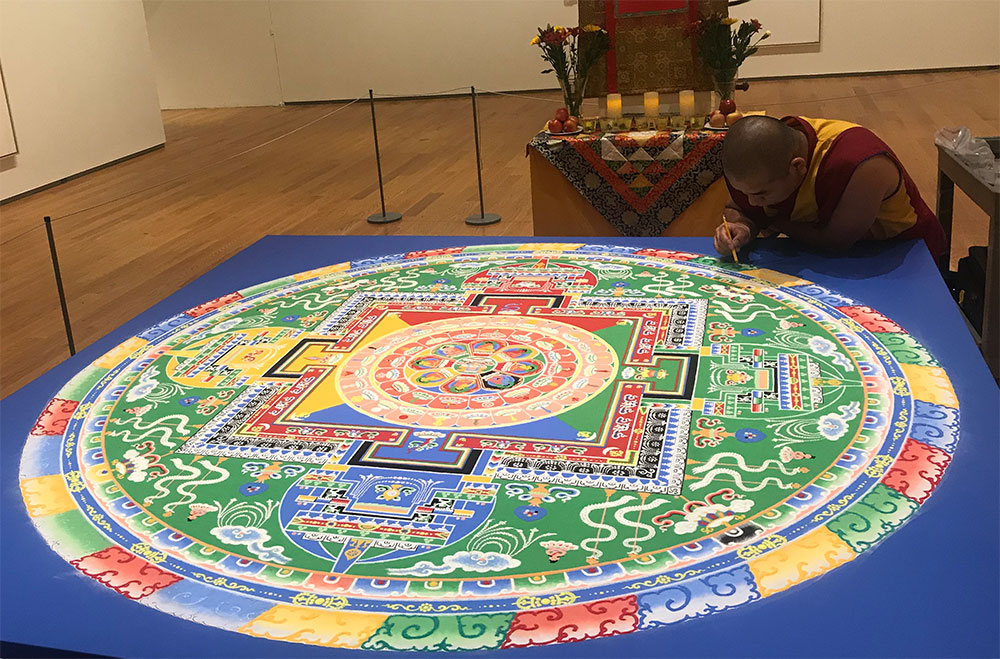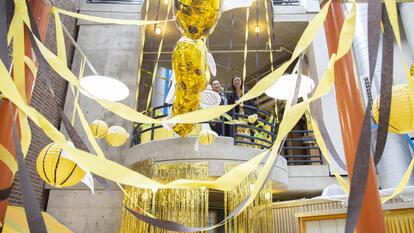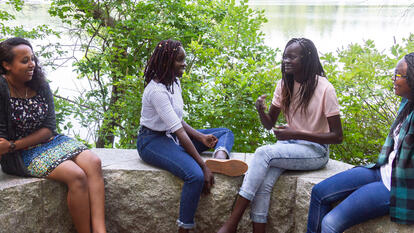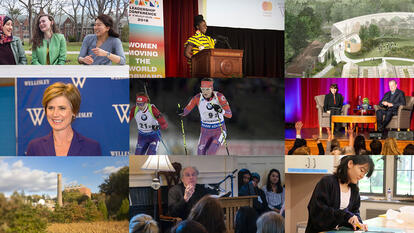Tibetan Monks Create Circles of Healing in a Sand Mandala at the Davis Museum

There’s still time to see something many people never will, right here on the Wellesley campus: the creation of an intricate sand mandala. Two visiting monks from the Namgyal Monastery Institute of Buddhist Studies in Ithaca, N.Y., began constructing the 6-by-6-foot healing mandala in the Davis Museum on September 21 amid the mandala paintings of artist Eddie Martinez. The monks will continue their work today, October 10, from 11 am to 1 pm and from 2 pm to 5 pm, and Wednesday, October 11, from 11 am to 1 pm. (Visitors can watch from two levels in the museum or via a live feed.) On Wednesday at 3 pm, the monks will perform the final step in the mandala process: a dissolution ceremony that will begin at the Davis and end at Lake Waban.
“It’s so interesting to see the interplay between this ephemeral mandala and the more permanent mandalas created by Eddie Martinez,” said Arthurina Fears, manager of museum and education programs at the Davis. “Every grain of sand contributes to an intricate pattern rich with symbolism, and we are so honored to learn more about the significance of this healing mandala from the visiting monks.”
Mandalas represent an architectural blueprint of the enlightened mind. In the center of the healing mandala are a lotus throne and eight Medicine Buddhas, which Buddhists believe came into the world to save sentient beings from shortened life spans, delusions, degenerate persons, time, and wrong views. There are three circles of lotus petals inside the mandala and another eight Medicine Buddhas seated on moon cushions in those intermediate circles. Disciples of the Medicine Buddhas are represented by symbols in outer circles.
The two monks, Lobsang Choegyal and Tenzin Choesang, who are Tibetan, drew the sophisticated design from memory in September; then they began placing sand in the center (pictured) and have slowly worked outward. The sand comes from the Himalayas, and pigment was added at their monastery in Ithaca. There are 49 colors in the mandala.
“This tantric mandala is the mind or palace of the medicine, or healing, Buddha,” said Choesang. “We have many problems in this world. We want to bring the blessings of the Buddha to people.”
Those blessings include clarity of mind and relief from fear, anger, aggression, and the sense of separation from other people and the world around us. “Creating or watching a mandala helps to free us from the three poisons of greed, hate, and delusion by helping us focus with our sensory awareness and freeing us to be present in the moment, rather than preoccupied about the past and the future,” said Kotatsu John Bailes, Wellesley’s Buddhist chaplain. “As we learn to focus our attention, the heart rate may drop, blood pressure may drop, the diaphragm and heart open, so we feel more loving, kind, and inclusive.”
Choesang explains it another way: “We [demonstrate] our enlightenment through the mandala. The mind is very tricky.”
The two monks begin and end each workday with prayers and chanting in front of a Tibetan altar near the mandala. Visitors are welcome to listen or join in, and to watch as the monks use metal file-like tools to carefully place the sand in precise locations on the mandala. The tools, rubbed together, make a rhythmic, repetitive sound, almost like a heartbeat.
“People have really enjoyed seeing the mandala,” said Fears. “Several community members come each day to watch and meditate. We have also had students, professors with their classes, and even a local Brownie troop visit.”
Marissa Bennett ’19, a double-major in economics and peace and justice studies who works at the Davis as a student visitor assistant, has spent many hours observing and listening to the making of the Medicine Buddha mandala. “Watching the work of the monks, Lobsang and Tenzin, has given me a new sense of calm. They are totally focused and in sync; it is beautiful to watch them work,” she said. “I tend to overthink a lot in my life, but I have found that listening to the rubbing of the cones and watching the sand fall into place clears my mind. I feel like I can really breathe—big, full, measured breaths that make me feel at peace.”
At the dissolution ceremony, the monks will begin with prayers and chanting, then they will sweep all of the mandala’s sand into a jar or silk bag and lead a procession to Lake Waban, where they will release the sand into the water.
“This ritual is a way of coming together, standing together, and sharing something that is not explainable,” said Bailes. “It also reminds us of the clear reality that everything in life is impermanent. Being present and doing our best in each moment is our gift to one another.”

Photo by Hui Xiong
Medicine Buddha Mandala—Creation and Dissolution is sponsored by the Davis Museum, with support from the Helyn MacLean Endowed Program Fund for Contemporary and South Asian Art, with additional support from the Office of Religious and Spiritual Life.



